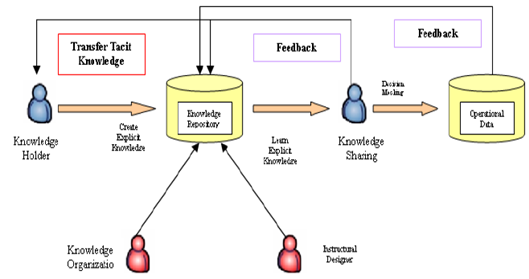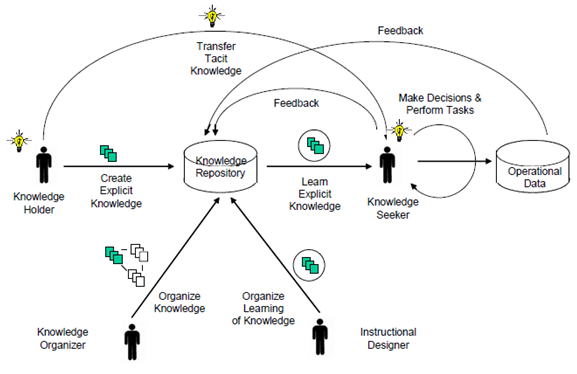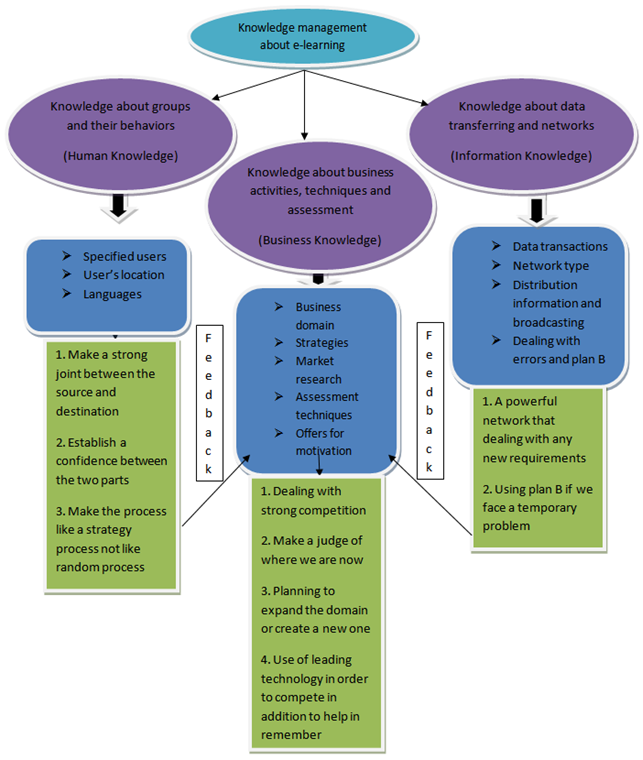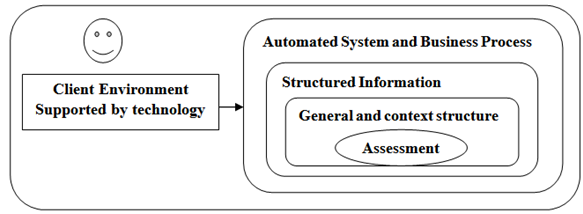-
Paper Information
- Previous Paper
- Paper Submission
-
Journal Information
- About This Journal
- Editorial Board
- Current Issue
- Archive
- Author Guidelines
- Contact Us
Management
p-ISSN: 2162-9374 e-ISSN: 2162-8416
2013; 3(6): 316-322
doi:10.5923/j.mm.20130306.04
Applying Knowledge Management Oriented Objectives into Distance E-Learning Process and Strategies
Hamzah H. Elrehail1, Mahmood A. Trad1, Khaled M. Algraibeh2
1MBA student, BAU, Amman, 21166, Jordan
2Management information system, Ajloun National University, Ajloun, 22525, Jordan
Correspondence to: Hamzah H. Elrehail, MBA student, BAU, Amman, 21166, Jordan.
| Email: |  |
Copyright © 2012 Scientific & Academic Publishing. All Rights Reserved.
Every day the technology goes forward, many and many applications are developed to solve any problem that the people face and those technologies applied in various domains. One of these domains is called E-learning as a part of two dominated domains knowledge management and networking. In this paper, we suggest a model to solve some challenges of distance e-learning by applying the appropriate concepts of knowledge management and how can mix the specified and true terms of knowledge management together to make a profit for our market.
Keywords: Knowledge Management, Distance E-Learning, Integration of Knowledge Management and E-Learning
Cite this paper: Hamzah H. Elrehail, Mahmood A. Trad, Khaled M. Algraibeh, Applying Knowledge Management Oriented Objectives into Distance E-Learning Process and Strategies, Management, Vol. 3 No. 6, 2013, pp. 316-322. doi: 10.5923/j.mm.20130306.04.
Article Outline
1. Introduction
- Knowledge Management is one of the widest definitions because it goes with all in formation in all branches. There are several viewpoints of the definition of knowledge management because there are intersections with anyone (organization) define this term. Knowledge Management is using in Systems, managing knowledge assets, methods and techniques, A definition of Knowledge Management (KM) concept : “the systematic process of finding, selecting, organizing, distilling, and presenting information in a way that improve an employee’s comprehension in specific area of interest”[11].E-learning is using computers and networks to transfer text, media, videos, animations and streaming audio. More and more information need to more classification and manage.This knowledge management is necessary. So, Knowledge management has several phases (Socialization, Externalization, Combination, Internalization and Cognition)[1]. Knowledge Management aims to fostering and managing processes like knowledge creation, transfer, application, and evolution in order to create value within the organization[2].
2. Problem Statement and Scope
- In this paper, we will discuss and explore Distance E- learning challenges when applying knowledge management aspects and objectives. In addition, we will explain if there are any objectives that are contradict with Distance E-learning objectives and border lines or if there are some knowledge management points can’t applied.According to[3], distance e-learning have several challenges, some of these challenges are:1. Lack of quality assessment and feedback, which hinders learning.2. Lack of student motivation3. Lack of personal community and connection (not blended learning).4. Some self-directed learners is sometimes too random and has no process ( it’s too loosely joined–sometimes you need a bridge or a path). Also, some is subject to quality issues. The learner has to self-analyze content without requisite knowledge or criteria5. Focus on memorization over learning core competencies.6. Underutilized talents and facilities.In this paper, we will discuss each challenge and explain if there is any contradiction when applying knowledge management with distance e-learning. In this paper, we aim to enhance the distance e-learning process when applying knowledge management. In addition, minimize the impact and present a contribution to reduce the impact of the challenges as far as possible. We will list some tools for enhancing knowledge management.According to[12], A taxonomy of knowledge management software tools, some enhancing tools are :1. Intranet.2. Web portals.3. Content management.4. Document management system. 5. Business process Re-engineering.6. Data mining.7. Knowledge creation application.8. Customer relationship management. Moreover, we will suggest a framework for best using of knowledge management aspects associated with distance e-learning process. To show the relationship between the knowledge management and the distance E-learning process and there effects on each other.
3. Literature Review
- In this section, we present some of previous researches that have been done on applying knowledge management into e-learning process and on the integration of them. Also, we review some of the approaches and models that had been used for integrating knowledge management and e-learning. In addition, we show some articles that discuss the role of knowledge management and e-learning in professional development, and we present some case studies of integration knowledge management and e-learning.According to[2], the professionalism in the work requires continuous learning and teaching on the part of the knowledge worker, this show that learning and teaching are inherent to knowledge work. Knowledge management considers knowledge as a key asset in any organization and focuses on its role for action within the organization which is necessary for its success. On the other hand, e-learning focuses on the learning processes of individuals and qualification and development of their skills. The article showed some contributions of this special issue consider knowledge management aspects and their integration with technology-enhanced learning such as: knowledge transfer through synchronous Online-learning, knowledge Sharing instruments and the adaption for learning arrangements, and the work process oriented learning environment as an index to virtual communities of practice networks[2].As described in[4], the integration of e-learning systems and knowledge management technology should be investigated; in order to improve the capture, organization and delivery of both traditional training courses and large amounts of corporate knowledge. The research answers the question of "how can integrate between knowledge management and e-learning systems? ". The article summarizes the importance of the integration of knowledge management and e-learning in the following points:Ø Powerful use of learning materials knowledge management with e-learning system.Ø Improvement learning efficiency through knowledge management and learning feedback.Ø Using knowledge management activity can cost less time in making teaching materials for teacher.
 | Figure 1. Competence Gaps between Knowledge Management and E-Learning[4] |
 | Figure 2. E-Learning System Enhancements to Knowledge Management[4] |
 | Figure 3. Knowledge Management Phases without E-Learning Enhancements[5] |
 | Figure 4. Knowledge Management Phases with E-Learning Enhancements[5] |
 | Figure 5. The Integrated Knowledge Management Learning Cycle[7] |
 | Figure 6. Our framework |
4. Framework
- In this section, we will make a methodology that connects knowledge management with distance e-learning. As we seen from pervious researchers the knowledge management look like a sky that have many clouds and to make a rain we need to connect all clouds together; in other words, knowledge management have many concepts. So, the idea to make a powerful e-learning is to collect just the concepts for our area and connect those concepts in ideal way to get the benefit. When applying knowledge management on distance e-learning we must take into account some requirements to solve. Distance e-learning means that we need a network to connect the source (e.g. instructor) with the destination (e.g. student). So, we need to know the specification of the internal and external network. In addition, we need to analyze the requirements to solve challenges that we mentioned in problem statement scope.Figure 6, show our framework.As described in our methodology, we deal with the six challenges that we mentioned in the problem statement section. Knowledge management will dealing with three parts of knowledge:1. Human knowledge2. Business Knowledge3. Information KnowledgeEach of them has different perspectives despite of they have many connections in background.
4.1. Human Knowledge
- Human knowledge is dealing with people, their behavior, location, languages and goals. In addition, knowledge management must dealing with this and connects all those concepts together to make a maximum benefit as well as that leads to make a strong joint between the source and destination. In addition, establish the confidence and make the process as standard not as random.
4.2. Business Knowledge
- Business knowledge is dealing with business domain, marketing and planning. In addition if we make another domain in future.Using business knowledge in e-learning is important to make assessment and judge about company or the real situation.
4.3. Information Knowledge
- Information Knowledge is dealing with the network type and every transaction that made. In addition, it deals with broadcasting of the information as well as with errors and the point that move to plan B. it’s too much important to have a powerful network and information that can recover from any problem.Knowledge direction shows the direction of knowledge from client side to assessment;Starting from client environment then automated system to structured information then context and general structure and finally the assessment.
 | Figure 7. Knowledge Direction |
5. Conclusions
- Knowledge Management is one of the widest definitions because it goes with all in- formation in all branches. E-learning as one of the web-based learning aspects is deeply associated with knowledge management. There are many relationships between those two aspects and when apply the knowledge management concepts we gain a powerful e-learning system. In this paper, we deal with six challenges of e-learning and we suggest a framework to make powerful e-learning with competition advantages. In addition, we present the strength points of applying the knowledge management in distance e-learning. with this framework we can improve the benefits of using knowledge management for enhancing the cycle of E-learning and Distance E-learning system with simple framework, the development of the cycle will be give a competitive advantage for organization and people work in organization. In future work, we will make an example for systemized model that deal with all of these concepts.
 Abstract
Abstract Reference
Reference Full-Text PDF
Full-Text PDF Full-text HTML
Full-text HTML